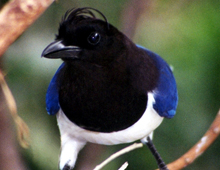Description: The black frontal crest for which the Curl-crested jay gets its name is visible at all times and is never laid flat. Only males have the crest, but otherwise the sexes are similar in coloring. The head, neck, and chest are a sooty black, with the rest of the upper body a dull violet-blue. Under- parts are white, as well as the tip of the tail.
Size: Adults grow to approximately 13.6 inches (34.5 cm) in length.
Behavior: Usually seen in groups of eight to twelve, Curl-crested jays are highly social. They are also thought to be nomadic during the non- breeding season.
Diet: Curl-crested jays are omnivores and will eat almost anything, including the eggs and nestlings of other birds, insects, arthropods, and small vertebrates. They also eat palm nuts and fruit from various trees.
Senses: They have a strong sense of sight that aids them in avoiding predators and looking for food.
Communication: Sometimes mistaken for crows because their calls are so similar, Curl-crested jays make a loud “gray, graa, gray-gray-gray” call that is sometimes repeated eight to ten times.
Reproduction: The breeding season runs from September to March. Average clutch size is five to six eggs, but not all of the eggs survive the incubation period. Incubation lasts 18-20 days.
Predation is the chief cause of nesting failure. Eggs are incubated and young are cared for by several individuals, which suggests that these jays are cooperative breeders. Nests are cup-shaped and are built from twigs lined with thin vegetation.
Habitat/range: Curl-crested jays are found in forests, woodlands and woodland edges and even into agricultural areas of scrub and groves in Bolivia, Brazil, and Paraguay.
Status: Listed as Least Concern on the IUCN Red List.



